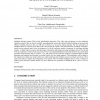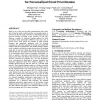2082 search results - page 401 / 417 » Using model knowledge for learning inverse dynamics |
ATAL
2003
Springer
14 years 1 months ago
2003
Springer
This paper describes the implementation and evaluation of a framework for modeling emotions in complex, decision-making agents. Sponsored by U.S. Army Research Institute (ARI), th...
IADIS
2003
13 years 10 months ago
2003
Intelligent tutoring systems (ITS) provide individualised instruction. They offer many advantages over the traditional classroom scenario: they are always available, non-judgement...
WWW
2009
ACM
14 years 9 months ago
2009
ACM
Understanding the intent behind a user's query can help search engine to automatically route the query to some corresponding vertical search engines to obtain particularly re...
KDD
2009
ACM
14 years 9 months ago
2009
ACM
Email is one of the most prevalent communication tools today, and solving the email overload problem is pressingly urgent. A good way to alleviate email overload is to automatical...
AGENTS
1997
Springer
14 years 23 days ago
1997
Springer
We have been developing Rogue, an architecture that integrates high-level planning with a low-level executing robotic agent. Rogue is designed as the oce gofer task planner for X...



